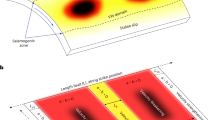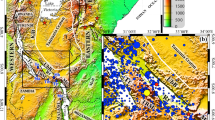Abstract
The geometry of a strike-slip fault system is an important component that influences the kinematics and interactions of the various faults within the system. Discontinuities and bends in the fault geometry not only determine the types of structures and the physiography that we observe along the fault system but also have a significant influence on the propagation of earthquake ruptures. A precise knowledge of the fault geometry, especially how it is segmented and other physical parameters, is essential for seismic hazard analysis. It is known that earthquake ruptures sometimes propagate over multiple faults by jumping from one segment to the next. A fault jump is a sudden dynamic coalescence of two faults separated by a step-over. Field observations suggest that a step-over width of 5 km is an appropriate maximum jump distance. Our study shows that between 2.5 and 6.5 km of step-over width, the probability of fault jump, for both releasing and restraining step-overs, decreases significantly from 100 to <10 %.






Similar content being viewed by others
References
Aki, K., 1979. Characterization of Barriers on an Earthquake Fault. Journal of Geophysical Research, 84, 6140–6148.
Aydin, A., and Du, Y. J., 1995. Surface Rupture at a Fault Bend—The 28 June 1992 Landers, California, Earthquake. Bulletin of The Seismological Society of America, 85(1), 111–128.
Barka, A. A., and Kadinsky-Cade, K., 1988. Strike-slip-Fault Geometry in Turkey and Its Influence on Earthquake Activity. Tectonics, 7(3), 663–684.
Duan. B., and Oglesby, D. D., 2006. Heterogeneous Fault Stresses from Previous Earthquakes and the Effect on Dynamics of Parallel Strike-Slip Faults. Journal of Geophysical Research, 111(B05309), doi:10.1029/2005JB004138,2006.
Harris, R. A., Archuleta, R. J., Day, S. M., 1991. Fault Steps and the Dynamic Rupture Process—2-D Numerical Simulations of a Spontaneously Propagating Shear Fracture. Geophysical Research Letters, 18(5), 893–896.
Harris, R. A., and Day, S. M., 1993. Dynamics of Fault Interaction—Parallel Strike-slip Faults. Journal of Geophysical Research-Solid Earth, 98(B3), 4461–4472.
Harris, R. A., and Day, S. M., 1999. Dynamic 3D Simulations of Earthquakes on En Echelon Faults. Geophysical Research Letters, 26(14), 2089–2092.
Kase, Y., and Kuge, K., 1998. Numerical simulation of spontaneous rupture processes on two non-coplanar faults: the effect of geometry on fault interaction. Geophysical Journal International, 135(3), 911–922, doi:10.1046/j.1365-246X.1998.00672.x.
Kase, Y., and Kuge, K., 2001. Rupture Propagation beyond Fault Discontinuities: Significance of Fault Strike and Location. Geophysical Journal International, 147(2), 330–342, doi:10.1046/j.1365-246X.2001.00533.x.
Knuepfer, P. L., 1989. Implications of the Characteristics of End-points of Historical Surface Fault Ruptures for the Nature of Fault Segmentation. U.S. Geological Survey Open File Report 89–315, 193–228.
Lindh, A. G., and Boore, D. M., 1981. Control of Rupture by Fault Geometry during the 1966 Parkfield Earthquake. Bulletin of The Seismological Society of America, 71(1), 95–116.
Lozos J. C., Oglesby, D. D., Brune, J. N., Olsen, K. B., 2012. Small Intermediate Fault Segments Can Either Aid or Hinder Rupture Propagation at Stepovers. Geophysical Research Letters, 39(L18305), 1–4, doi:10.1029/2012GL053005.
Oglesby, D. D., 2005. The Dynamics of Strike-slip Step-overs with Linking Dip-slip Faults. Bulletin of The Seismological Society of America, 95(5), 1604–1622.
Rundle, J. B., 1988. A physical model for earthquakes .2. Application to southern-California. Journal of Geophysical Research-Solid Earth, 93(B6), 6255–6274.
Rundle, P. B., Rundle, J. B., Tiampo, K. F., Donnellan, A., and Turcotte, D. L., 2006. Virtual California: Fault model, frictional parameters, and applications. Pure and Applied Geophysics, 163(9), 1819–1846.
Savage, J. C., 1983. A Dislocation Model of Strain Accumulation and Release at a Subduction Zone. Journal of Geophysical Research, 88(NB6), 4984–4996, doi:10.1029/JB088iB06p04984.
Segall, P., and Pollard, D. D., 1980. Mechanics of Discontinous Faults. Journal of Geophysical Research, 85(NB8), 4337–4350.
Sibson, R. H., 1985. Stopping of Earthquake Ruptures at Dilational Fault Jogs. Nature, 316(6025), 248–251.
Sieh, K., Jones, L., Haukkson, E., Hudnut, K., Eberhart-Phillips, D., Heaton, T., Hough. S., Hutton, K., Kanamori, H., Lilje, A., Lindvall, S., McGill, S. F.,Mori, J., Rubin, C., Spotila, J. A., Stock, J., Thio, H. K., Treiman, J, Wernicke, B., Zachariasen, J., 1993. Near-Field Investigations of the Landers Earthquake Sequence, April to July 1992. Science, 260(5105), 171–176, doi:10.1126/science.260.5105.171.
Wald, D. J., and Heaton, T. H., 1994. Spatial and Temporal Distribution of Slip for the 1992 Landers, California, Earthquake. Bulletin of The Seismological Society of America, 84(3), 668–691.
Wesnousky, S. G., 1988. Seismological and Structural Evolution of Strike-Slip Faults. Nature, 335(6188), 340–342.
Wesnousky, S. G., 2006. Predicting the Endpoints of Earthquake Ruptures. Nature, 444(7117), 358–360.
Yıkılmaz, M. B., Turcotte, D.L., Yakovlev, G., Rundle, J. B., Kellogg. L. H., 2010. Virtual California simulations: Simple fault models and their application to an observed sequence of great earthquakes, Geophysical Journal International, 180, 734–742.
Yıkılmaz, M. B., Heien, E. M., Turcotte, D. L., Rundle, J. B., and Kellogg, L. H., 2011. A fault and seismicity based composite simulation in northern California, Nonlinear Processes in Geophysics, 18, 955–966.
Author information
Authors and Affiliations
Corresponding author
Rights and permissions
About this article
Cite this article
Yıkılmaz, M.B., Turcotte, D.L., Heien, E.M. et al. Critical Jump Distance for Propagating Earthquake Ruptures Across Step-Overs. Pure Appl. Geophys. 172, 2195–2201 (2015). https://doi.org/10.1007/s00024-014-0786-y
Received:
Revised:
Accepted:
Published:
Issue Date:
DOI: https://doi.org/10.1007/s00024-014-0786-y




